Person-Centered Care: Principles, Practices, and Patient Outcomes
VerifiedAdded on 2022/12/27
|9
|2143
|1
Essay
AI Summary
This essay delves into the concept of person-centered care (PCC) within healthcare settings, emphasizing its critical role in promoting patient wellbeing, safety, and positive outcomes. The paper begins by defining PCC and its core principles, highlighting the importance of human rights, dignity, and individualized care approaches. It explores the responsibilities of healthcare providers in fostering a patient-centered environment, including effective communication, risk assessment, and spiritual and emotional support. The essay uses the case study of Shelley, a registered nurse, to illustrate the practical application of PCC principles in an emergency room scenario. The essay further discusses the role of health promotion and community health initiatives in maintaining public wellbeing, and contrasts traditional healthcare models with the patient-centered approach. The conclusion underscores the collaborative nature of PCC, emphasizing the partnership between patients and healthcare providers and the importance of service quality in achieving optimal patient outcomes. The essay references multiple sources to support its arguments.
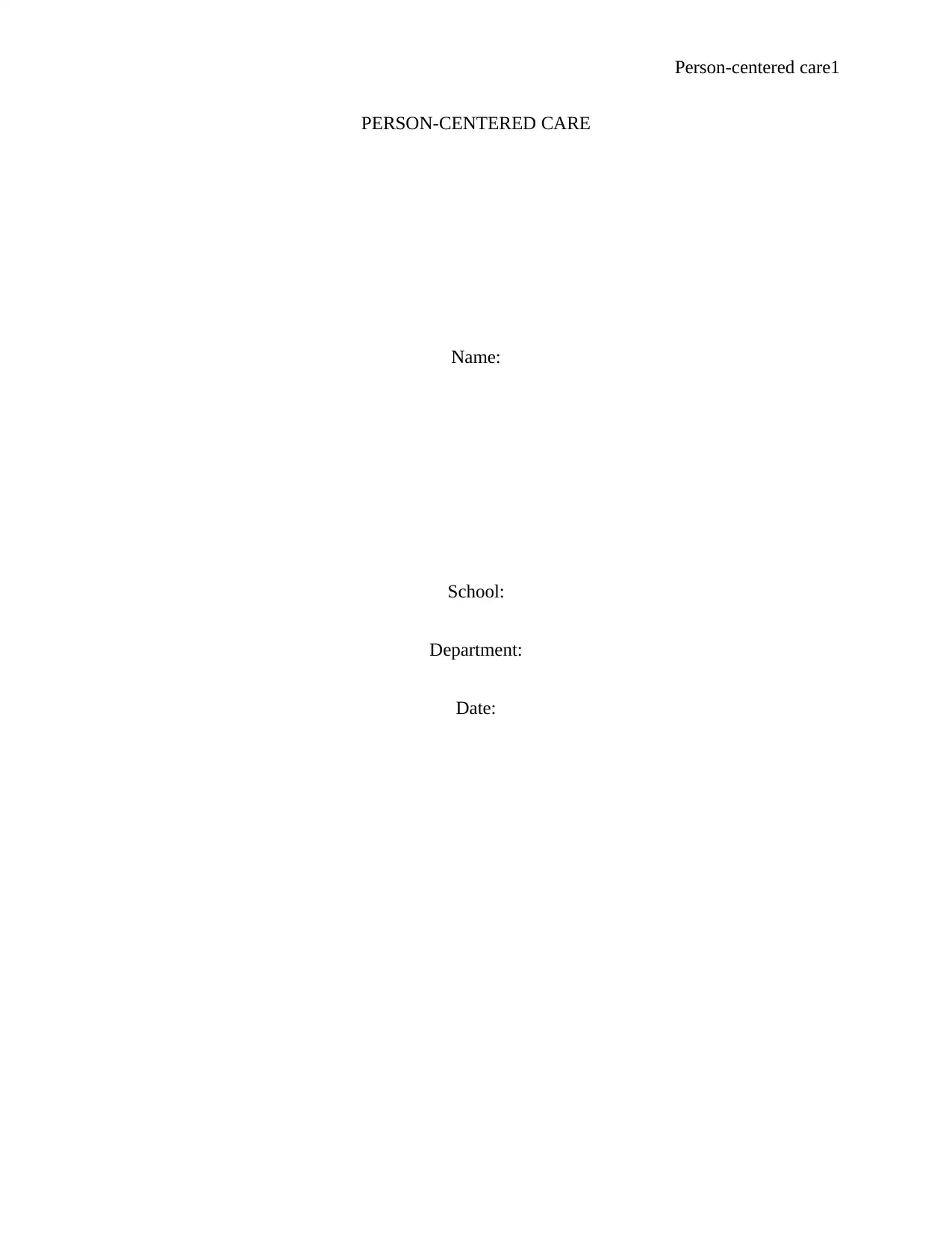
Person-centered care1
PERSON-CENTERED CARE
Name:
School:
Department:
Date:
PERSON-CENTERED CARE
Name:
School:
Department:
Date:
Paraphrase This Document
Need a fresh take? Get an instant paraphrase of this document with our AI Paraphraser
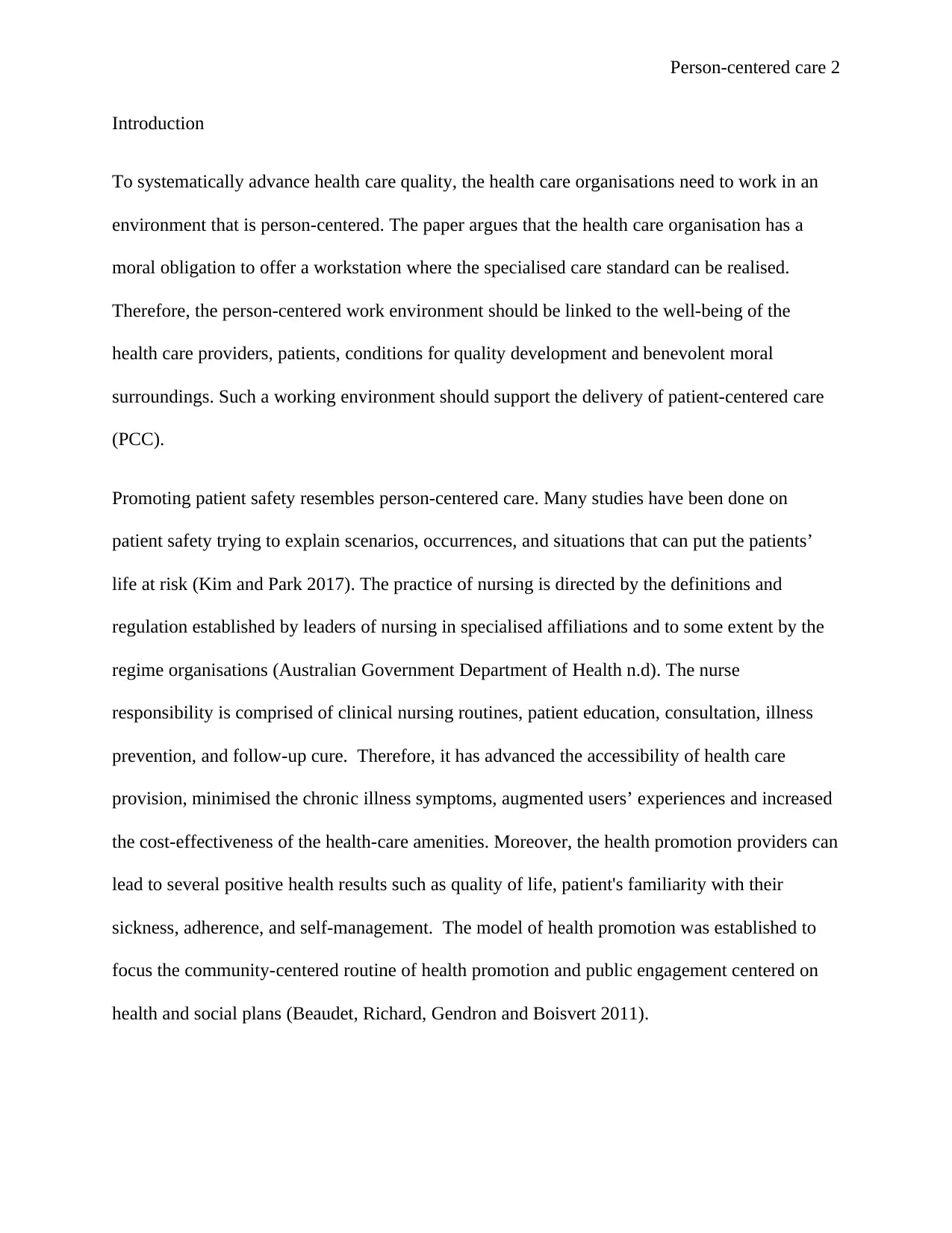
Person-centered care 2
Introduction
To systematically advance health care quality, the health care organisations need to work in an
environment that is person-centered. The paper argues that the health care organisation has a
moral obligation to offer a workstation where the specialised care standard can be realised.
Therefore, the person-centered work environment should be linked to the well-being of the
health care providers, patients, conditions for quality development and benevolent moral
surroundings. Such a working environment should support the delivery of patient-centered care
(PCC).
Promoting patient safety resembles person-centered care. Many studies have been done on
patient safety trying to explain scenarios, occurrences, and situations that can put the patients’
life at risk (Kim and Park 2017). The practice of nursing is directed by the definitions and
regulation established by leaders of nursing in specialised affiliations and to some extent by the
regime organisations (Australian Government Department of Health n.d). The nurse
responsibility is comprised of clinical nursing routines, patient education, consultation, illness
prevention, and follow-up cure. Therefore, it has advanced the accessibility of health care
provision, minimised the chronic illness symptoms, augmented users’ experiences and increased
the cost-effectiveness of the health-care amenities. Moreover, the health promotion providers can
lead to several positive health results such as quality of life, patient's familiarity with their
sickness, adherence, and self-management. The model of health promotion was established to
focus the community-centered routine of health promotion and public engagement centered on
health and social plans (Beaudet, Richard, Gendron and Boisvert 2011).
Introduction
To systematically advance health care quality, the health care organisations need to work in an
environment that is person-centered. The paper argues that the health care organisation has a
moral obligation to offer a workstation where the specialised care standard can be realised.
Therefore, the person-centered work environment should be linked to the well-being of the
health care providers, patients, conditions for quality development and benevolent moral
surroundings. Such a working environment should support the delivery of patient-centered care
(PCC).
Promoting patient safety resembles person-centered care. Many studies have been done on
patient safety trying to explain scenarios, occurrences, and situations that can put the patients’
life at risk (Kim and Park 2017). The practice of nursing is directed by the definitions and
regulation established by leaders of nursing in specialised affiliations and to some extent by the
regime organisations (Australian Government Department of Health n.d). The nurse
responsibility is comprised of clinical nursing routines, patient education, consultation, illness
prevention, and follow-up cure. Therefore, it has advanced the accessibility of health care
provision, minimised the chronic illness symptoms, augmented users’ experiences and increased
the cost-effectiveness of the health-care amenities. Moreover, the health promotion providers can
lead to several positive health results such as quality of life, patient's familiarity with their
sickness, adherence, and self-management. The model of health promotion was established to
focus the community-centered routine of health promotion and public engagement centered on
health and social plans (Beaudet, Richard, Gendron and Boisvert 2011).
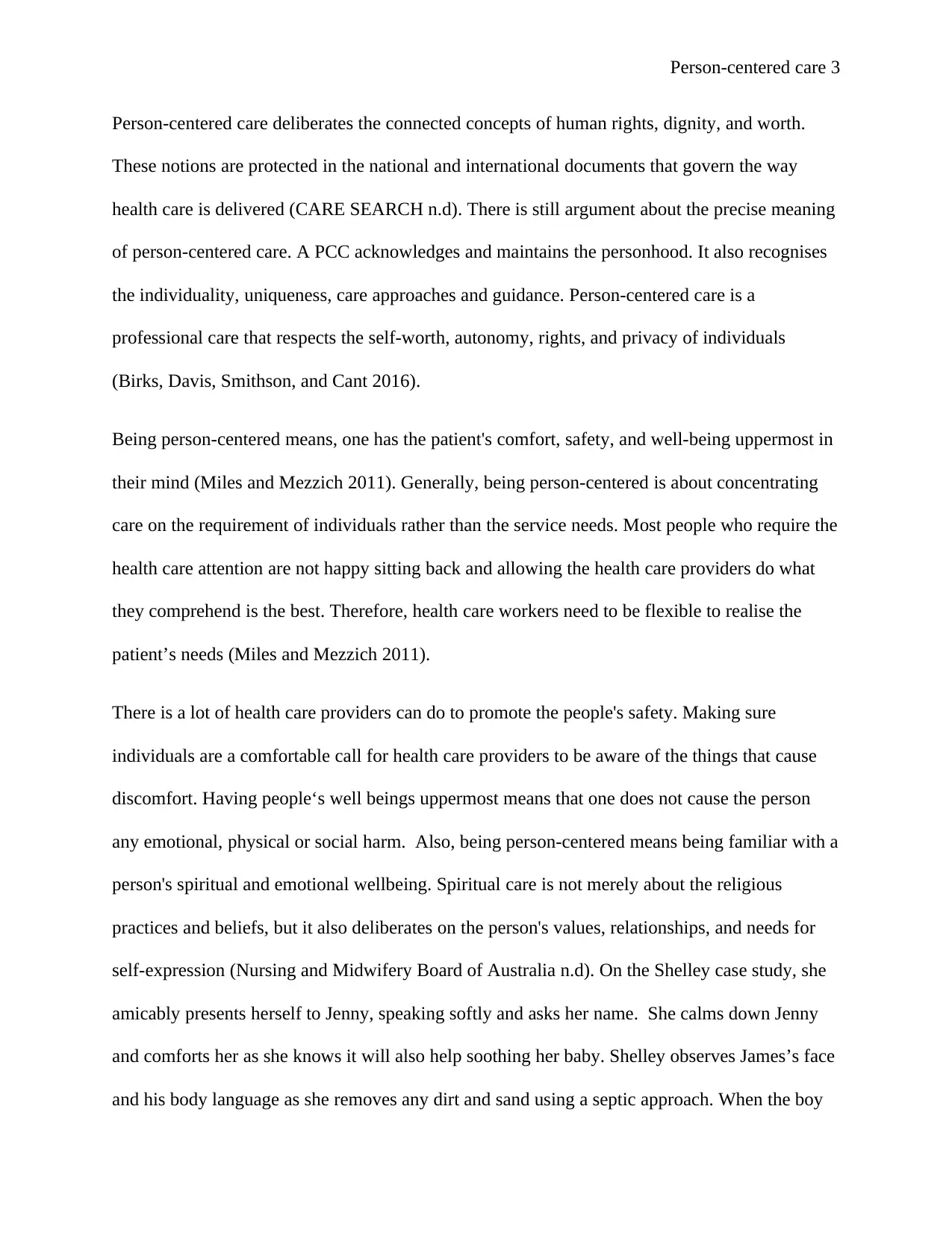
Person-centered care 3
Person-centered care deliberates the connected concepts of human rights, dignity, and worth.
These notions are protected in the national and international documents that govern the way
health care is delivered (CARE SEARCH n.d). There is still argument about the precise meaning
of person-centered care. A PCC acknowledges and maintains the personhood. It also recognises
the individuality, uniqueness, care approaches and guidance. Person-centered care is a
professional care that respects the self-worth, autonomy, rights, and privacy of individuals
(Birks, Davis, Smithson, and Cant 2016).
Being person-centered means, one has the patient's comfort, safety, and well-being uppermost in
their mind (Miles and Mezzich 2011). Generally, being person-centered is about concentrating
care on the requirement of individuals rather than the service needs. Most people who require the
health care attention are not happy sitting back and allowing the health care providers do what
they comprehend is the best. Therefore, health care workers need to be flexible to realise the
patient’s needs (Miles and Mezzich 2011).
There is a lot of health care providers can do to promote the people's safety. Making sure
individuals are a comfortable call for health care providers to be aware of the things that cause
discomfort. Having people‘s well beings uppermost means that one does not cause the person
any emotional, physical or social harm. Also, being person-centered means being familiar with a
person's spiritual and emotional wellbeing. Spiritual care is not merely about the religious
practices and beliefs, but it also deliberates on the person's values, relationships, and needs for
self-expression (Nursing and Midwifery Board of Australia n.d). On the Shelley case study, she
amicably presents herself to Jenny, speaking softly and asks her name. She calms down Jenny
and comforts her as she knows it will also help soothing her baby. Shelley observes James’s face
and his body language as she removes any dirt and sand using a septic approach. When the boy
Person-centered care deliberates the connected concepts of human rights, dignity, and worth.
These notions are protected in the national and international documents that govern the way
health care is delivered (CARE SEARCH n.d). There is still argument about the precise meaning
of person-centered care. A PCC acknowledges and maintains the personhood. It also recognises
the individuality, uniqueness, care approaches and guidance. Person-centered care is a
professional care that respects the self-worth, autonomy, rights, and privacy of individuals
(Birks, Davis, Smithson, and Cant 2016).
Being person-centered means, one has the patient's comfort, safety, and well-being uppermost in
their mind (Miles and Mezzich 2011). Generally, being person-centered is about concentrating
care on the requirement of individuals rather than the service needs. Most people who require the
health care attention are not happy sitting back and allowing the health care providers do what
they comprehend is the best. Therefore, health care workers need to be flexible to realise the
patient’s needs (Miles and Mezzich 2011).
There is a lot of health care providers can do to promote the people's safety. Making sure
individuals are a comfortable call for health care providers to be aware of the things that cause
discomfort. Having people‘s well beings uppermost means that one does not cause the person
any emotional, physical or social harm. Also, being person-centered means being familiar with a
person's spiritual and emotional wellbeing. Spiritual care is not merely about the religious
practices and beliefs, but it also deliberates on the person's values, relationships, and needs for
self-expression (Nursing and Midwifery Board of Australia n.d). On the Shelley case study, she
amicably presents herself to Jenny, speaking softly and asks her name. She calms down Jenny
and comforts her as she knows it will also help soothing her baby. Shelley observes James’s face
and his body language as she removes any dirt and sand using a septic approach. When the boy
⊘ This is a preview!⊘
Do you want full access?
Subscribe today to unlock all pages.

Trusted by 1+ million students worldwide
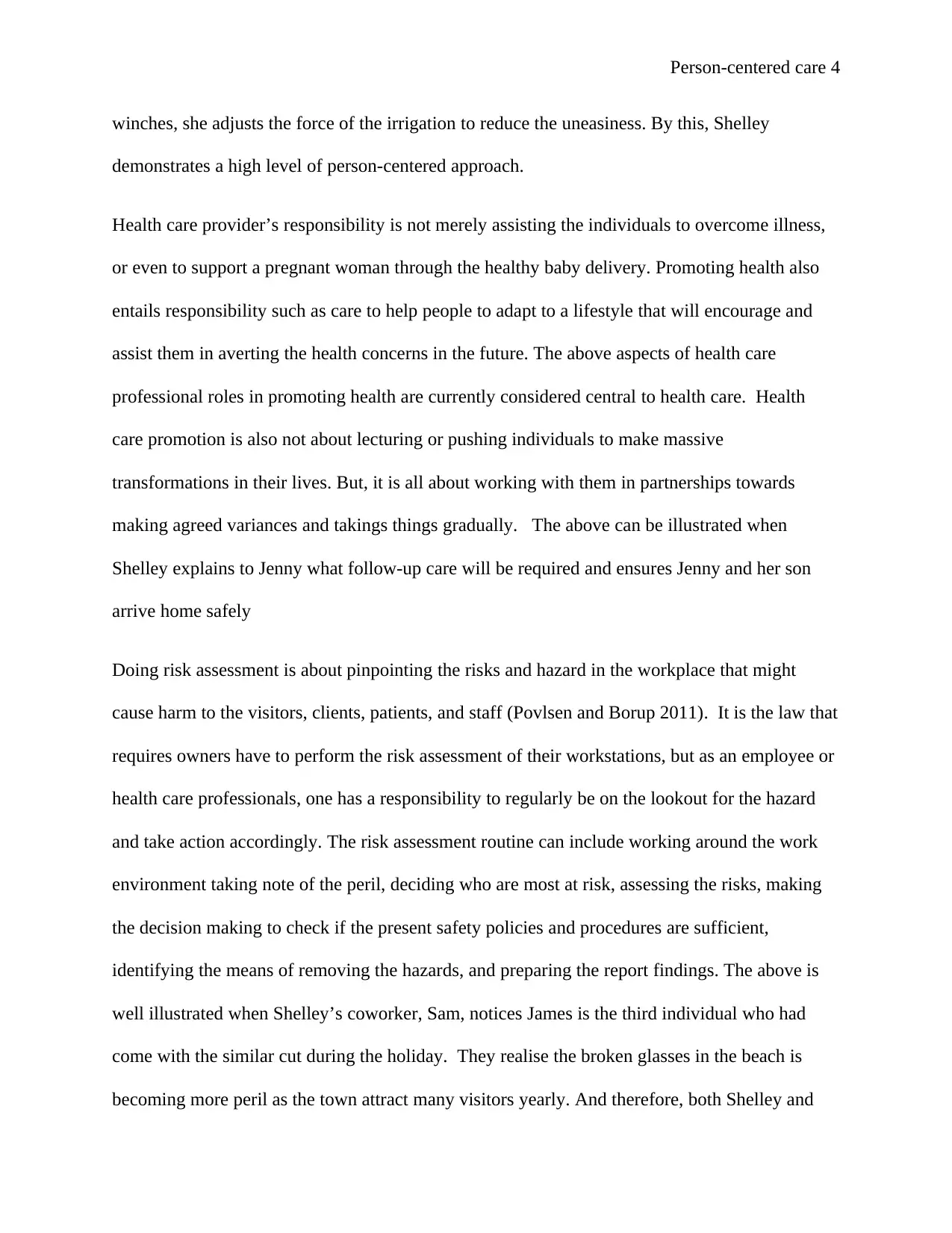
Person-centered care 4
winches, she adjusts the force of the irrigation to reduce the uneasiness. By this, Shelley
demonstrates a high level of person-centered approach.
Health care provider’s responsibility is not merely assisting the individuals to overcome illness,
or even to support a pregnant woman through the healthy baby delivery. Promoting health also
entails responsibility such as care to help people to adapt to a lifestyle that will encourage and
assist them in averting the health concerns in the future. The above aspects of health care
professional roles in promoting health are currently considered central to health care. Health
care promotion is also not about lecturing or pushing individuals to make massive
transformations in their lives. But, it is all about working with them in partnerships towards
making agreed variances and takings things gradually. The above can be illustrated when
Shelley explains to Jenny what follow-up care will be required and ensures Jenny and her son
arrive home safely
Doing risk assessment is about pinpointing the risks and hazard in the workplace that might
cause harm to the visitors, clients, patients, and staff (Povlsen and Borup 2011). It is the law that
requires owners have to perform the risk assessment of their workstations, but as an employee or
health care professionals, one has a responsibility to regularly be on the lookout for the hazard
and take action accordingly. The risk assessment routine can include working around the work
environment taking note of the peril, deciding who are most at risk, assessing the risks, making
the decision making to check if the present safety policies and procedures are sufficient,
identifying the means of removing the hazards, and preparing the report findings. The above is
well illustrated when Shelley’s coworker, Sam, notices James is the third individual who had
come with the similar cut during the holiday. They realise the broken glasses in the beach is
becoming more peril as the town attract many visitors yearly. And therefore, both Shelley and
winches, she adjusts the force of the irrigation to reduce the uneasiness. By this, Shelley
demonstrates a high level of person-centered approach.
Health care provider’s responsibility is not merely assisting the individuals to overcome illness,
or even to support a pregnant woman through the healthy baby delivery. Promoting health also
entails responsibility such as care to help people to adapt to a lifestyle that will encourage and
assist them in averting the health concerns in the future. The above aspects of health care
professional roles in promoting health are currently considered central to health care. Health
care promotion is also not about lecturing or pushing individuals to make massive
transformations in their lives. But, it is all about working with them in partnerships towards
making agreed variances and takings things gradually. The above can be illustrated when
Shelley explains to Jenny what follow-up care will be required and ensures Jenny and her son
arrive home safely
Doing risk assessment is about pinpointing the risks and hazard in the workplace that might
cause harm to the visitors, clients, patients, and staff (Povlsen and Borup 2011). It is the law that
requires owners have to perform the risk assessment of their workstations, but as an employee or
health care professionals, one has a responsibility to regularly be on the lookout for the hazard
and take action accordingly. The risk assessment routine can include working around the work
environment taking note of the peril, deciding who are most at risk, assessing the risks, making
the decision making to check if the present safety policies and procedures are sufficient,
identifying the means of removing the hazards, and preparing the report findings. The above is
well illustrated when Shelley’s coworker, Sam, notices James is the third individual who had
come with the similar cut during the holiday. They realise the broken glasses in the beach is
becoming more peril as the town attract many visitors yearly. And therefore, both Shelley and
Paraphrase This Document
Need a fresh take? Get an instant paraphrase of this document with our AI Paraphraser
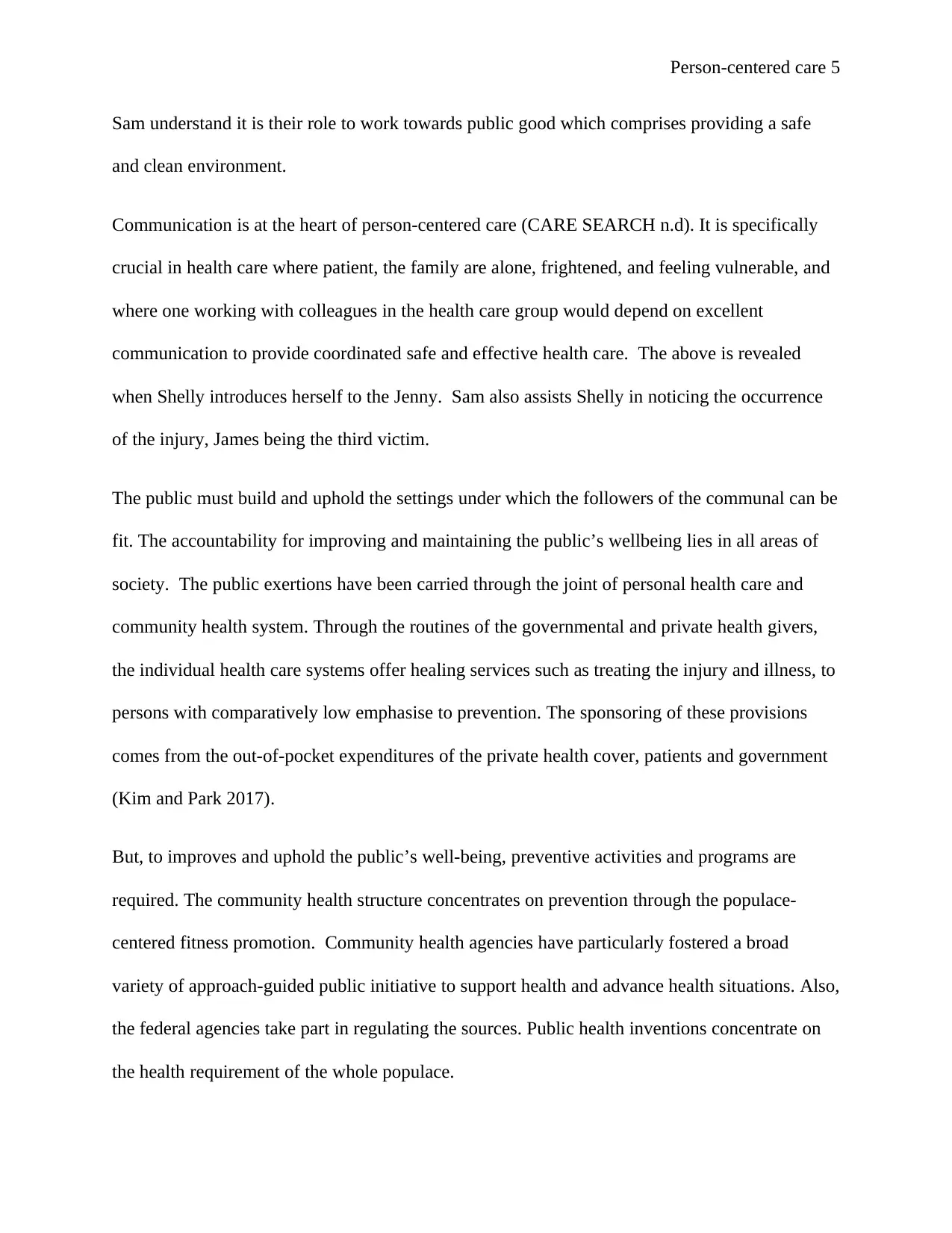
Person-centered care 5
Sam understand it is their role to work towards public good which comprises providing a safe
and clean environment.
Communication is at the heart of person-centered care (CARE SEARCH n.d). It is specifically
crucial in health care where patient, the family are alone, frightened, and feeling vulnerable, and
where one working with colleagues in the health care group would depend on excellent
communication to provide coordinated safe and effective health care. The above is revealed
when Shelly introduces herself to the Jenny. Sam also assists Shelly in noticing the occurrence
of the injury, James being the third victim.
The public must build and uphold the settings under which the followers of the communal can be
fit. The accountability for improving and maintaining the public’s wellbeing lies in all areas of
society. The public exertions have been carried through the joint of personal health care and
community health system. Through the routines of the governmental and private health givers,
the individual health care systems offer healing services such as treating the injury and illness, to
persons with comparatively low emphasise to prevention. The sponsoring of these provisions
comes from the out-of-pocket expenditures of the private health cover, patients and government
(Kim and Park 2017).
But, to improves and uphold the public’s well-being, preventive activities and programs are
required. The community health structure concentrates on prevention through the populace-
centered fitness promotion. Community health agencies have particularly fostered a broad
variety of approach-guided public initiative to support health and advance health situations. Also,
the federal agencies take part in regulating the sources. Public health inventions concentrate on
the health requirement of the whole populace.
Sam understand it is their role to work towards public good which comprises providing a safe
and clean environment.
Communication is at the heart of person-centered care (CARE SEARCH n.d). It is specifically
crucial in health care where patient, the family are alone, frightened, and feeling vulnerable, and
where one working with colleagues in the health care group would depend on excellent
communication to provide coordinated safe and effective health care. The above is revealed
when Shelly introduces herself to the Jenny. Sam also assists Shelly in noticing the occurrence
of the injury, James being the third victim.
The public must build and uphold the settings under which the followers of the communal can be
fit. The accountability for improving and maintaining the public’s wellbeing lies in all areas of
society. The public exertions have been carried through the joint of personal health care and
community health system. Through the routines of the governmental and private health givers,
the individual health care systems offer healing services such as treating the injury and illness, to
persons with comparatively low emphasise to prevention. The sponsoring of these provisions
comes from the out-of-pocket expenditures of the private health cover, patients and government
(Kim and Park 2017).
But, to improves and uphold the public’s well-being, preventive activities and programs are
required. The community health structure concentrates on prevention through the populace-
centered fitness promotion. Community health agencies have particularly fostered a broad
variety of approach-guided public initiative to support health and advance health situations. Also,
the federal agencies take part in regulating the sources. Public health inventions concentrate on
the health requirement of the whole populace.
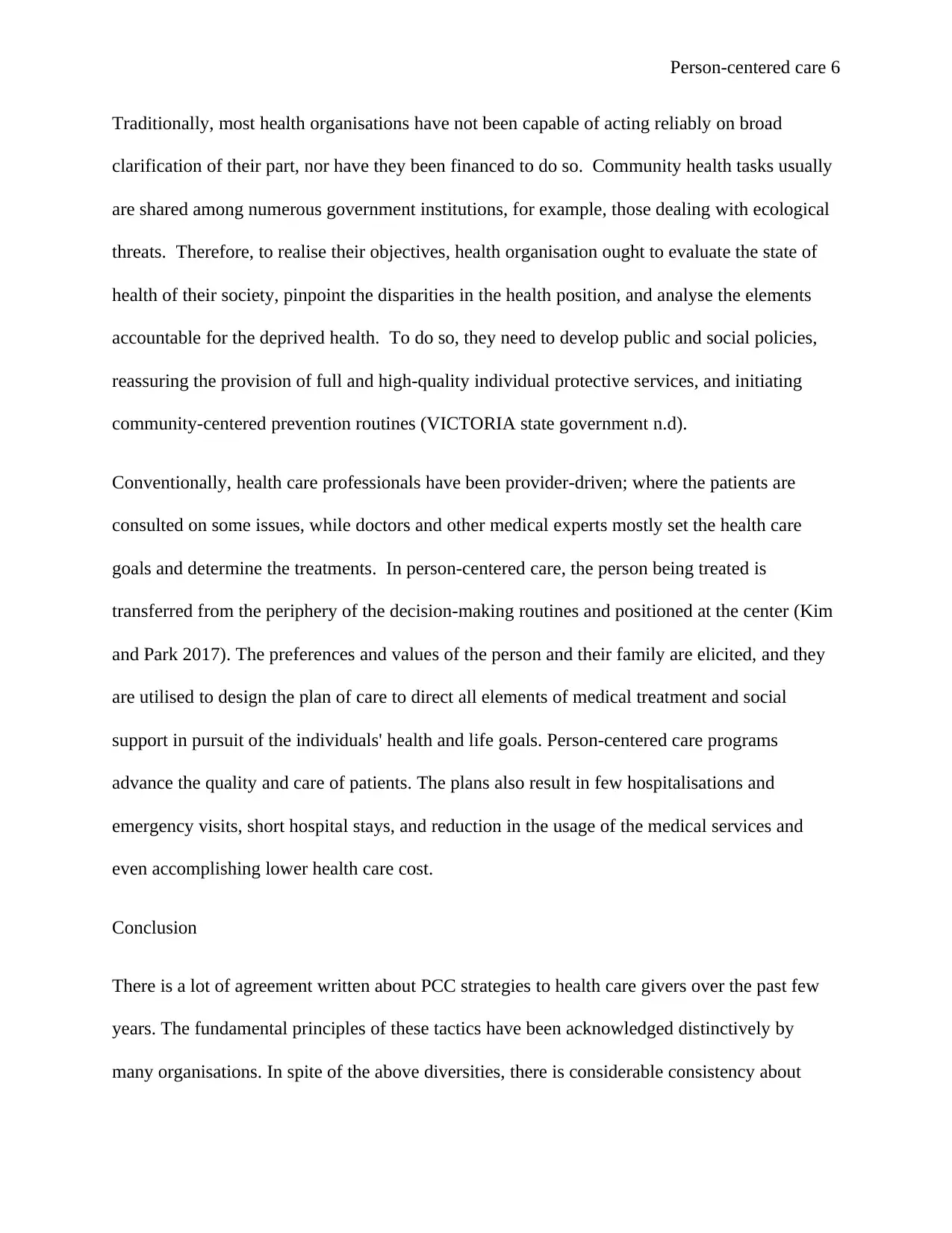
Person-centered care 6
Traditionally, most health organisations have not been capable of acting reliably on broad
clarification of their part, nor have they been financed to do so. Community health tasks usually
are shared among numerous government institutions, for example, those dealing with ecological
threats. Therefore, to realise their objectives, health organisation ought to evaluate the state of
health of their society, pinpoint the disparities in the health position, and analyse the elements
accountable for the deprived health. To do so, they need to develop public and social policies,
reassuring the provision of full and high-quality individual protective services, and initiating
community-centered prevention routines (VICTORIA state government n.d).
Conventionally, health care professionals have been provider-driven; where the patients are
consulted on some issues, while doctors and other medical experts mostly set the health care
goals and determine the treatments. In person-centered care, the person being treated is
transferred from the periphery of the decision-making routines and positioned at the center (Kim
and Park 2017). The preferences and values of the person and their family are elicited, and they
are utilised to design the plan of care to direct all elements of medical treatment and social
support in pursuit of the individuals' health and life goals. Person-centered care programs
advance the quality and care of patients. The plans also result in few hospitalisations and
emergency visits, short hospital stays, and reduction in the usage of the medical services and
even accomplishing lower health care cost.
Conclusion
There is a lot of agreement written about PCC strategies to health care givers over the past few
years. The fundamental principles of these tactics have been acknowledged distinctively by
many organisations. In spite of the above diversities, there is considerable consistency about
Traditionally, most health organisations have not been capable of acting reliably on broad
clarification of their part, nor have they been financed to do so. Community health tasks usually
are shared among numerous government institutions, for example, those dealing with ecological
threats. Therefore, to realise their objectives, health organisation ought to evaluate the state of
health of their society, pinpoint the disparities in the health position, and analyse the elements
accountable for the deprived health. To do so, they need to develop public and social policies,
reassuring the provision of full and high-quality individual protective services, and initiating
community-centered prevention routines (VICTORIA state government n.d).
Conventionally, health care professionals have been provider-driven; where the patients are
consulted on some issues, while doctors and other medical experts mostly set the health care
goals and determine the treatments. In person-centered care, the person being treated is
transferred from the periphery of the decision-making routines and positioned at the center (Kim
and Park 2017). The preferences and values of the person and their family are elicited, and they
are utilised to design the plan of care to direct all elements of medical treatment and social
support in pursuit of the individuals' health and life goals. Person-centered care programs
advance the quality and care of patients. The plans also result in few hospitalisations and
emergency visits, short hospital stays, and reduction in the usage of the medical services and
even accomplishing lower health care cost.
Conclusion
There is a lot of agreement written about PCC strategies to health care givers over the past few
years. The fundamental principles of these tactics have been acknowledged distinctively by
many organisations. In spite of the above diversities, there is considerable consistency about
⊘ This is a preview!⊘
Do you want full access?
Subscribe today to unlock all pages.

Trusted by 1+ million students worldwide
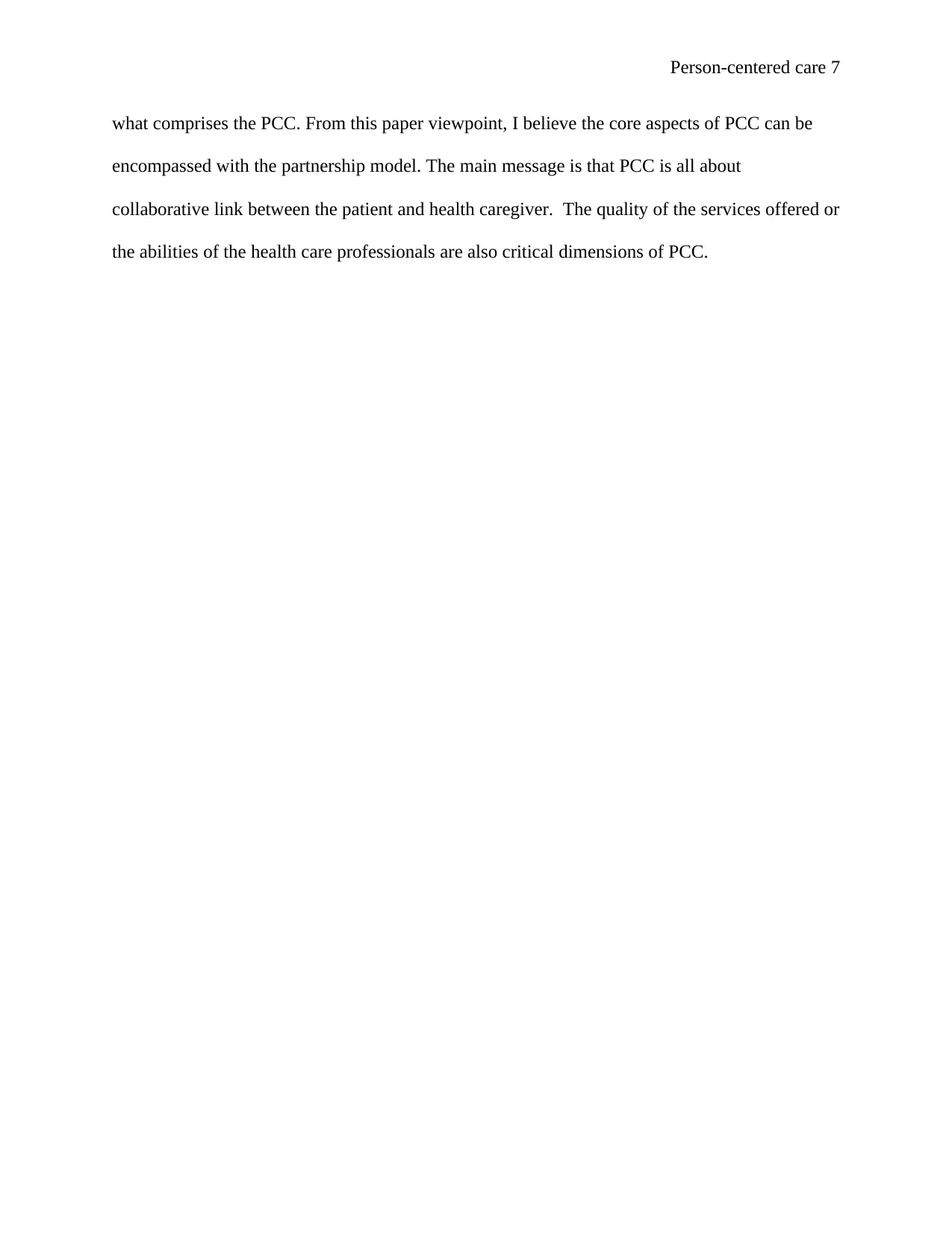
Person-centered care 7
what comprises the PCC. From this paper viewpoint, I believe the core aspects of PCC can be
encompassed with the partnership model. The main message is that PCC is all about
collaborative link between the patient and health caregiver. The quality of the services offered or
the abilities of the health care professionals are also critical dimensions of PCC.
what comprises the PCC. From this paper viewpoint, I believe the core aspects of PCC can be
encompassed with the partnership model. The main message is that PCC is all about
collaborative link between the patient and health caregiver. The quality of the services offered or
the abilities of the health care professionals are also critical dimensions of PCC.
Paraphrase This Document
Need a fresh take? Get an instant paraphrase of this document with our AI Paraphraser
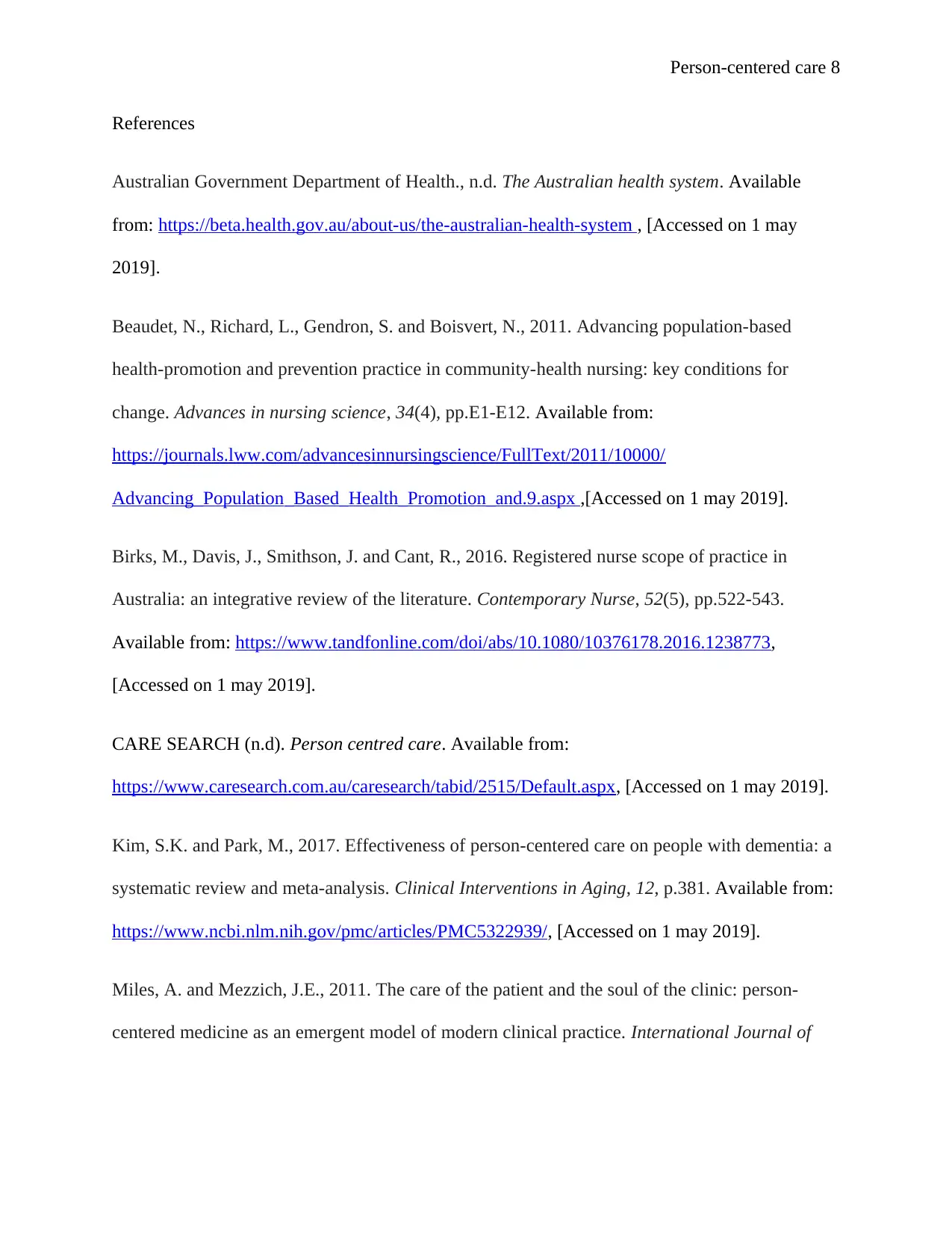
Person-centered care 8
References
Australian Government Department of Health., n.d. The Australian health system. Available
from: https://beta.health.gov.au/about-us/the-australian-health-system , [Accessed on 1 may
2019].
Beaudet, N., Richard, L., Gendron, S. and Boisvert, N., 2011. Advancing population-based
health-promotion and prevention practice in community-health nursing: key conditions for
change. Advances in nursing science, 34(4), pp.E1-E12. Available from:
https://journals.lww.com/advancesinnursingscience/FullText/2011/10000/
Advancing_Population_Based_Health_Promotion_and.9.aspx ,[Accessed on 1 may 2019].
Birks, M., Davis, J., Smithson, J. and Cant, R., 2016. Registered nurse scope of practice in
Australia: an integrative review of the literature. Contemporary Nurse, 52(5), pp.522-543.
Available from: https://www.tandfonline.com/doi/abs/10.1080/10376178.2016.1238773,
[Accessed on 1 may 2019].
CARE SEARCH (n.d). Person centred care. Available from:
https://www.caresearch.com.au/caresearch/tabid/2515/Default.aspx, [Accessed on 1 may 2019].
Kim, S.K. and Park, M., 2017. Effectiveness of person-centered care on people with dementia: a
systematic review and meta-analysis. Clinical Interventions in Aging, 12, p.381. Available from:
https://www.ncbi.nlm.nih.gov/pmc/articles/PMC5322939/, [Accessed on 1 may 2019].
Miles, A. and Mezzich, J.E., 2011. The care of the patient and the soul of the clinic: person-
centered medicine as an emergent model of modern clinical practice. International Journal of
References
Australian Government Department of Health., n.d. The Australian health system. Available
from: https://beta.health.gov.au/about-us/the-australian-health-system , [Accessed on 1 may
2019].
Beaudet, N., Richard, L., Gendron, S. and Boisvert, N., 2011. Advancing population-based
health-promotion and prevention practice in community-health nursing: key conditions for
change. Advances in nursing science, 34(4), pp.E1-E12. Available from:
https://journals.lww.com/advancesinnursingscience/FullText/2011/10000/
Advancing_Population_Based_Health_Promotion_and.9.aspx ,[Accessed on 1 may 2019].
Birks, M., Davis, J., Smithson, J. and Cant, R., 2016. Registered nurse scope of practice in
Australia: an integrative review of the literature. Contemporary Nurse, 52(5), pp.522-543.
Available from: https://www.tandfonline.com/doi/abs/10.1080/10376178.2016.1238773,
[Accessed on 1 may 2019].
CARE SEARCH (n.d). Person centred care. Available from:
https://www.caresearch.com.au/caresearch/tabid/2515/Default.aspx, [Accessed on 1 may 2019].
Kim, S.K. and Park, M., 2017. Effectiveness of person-centered care on people with dementia: a
systematic review and meta-analysis. Clinical Interventions in Aging, 12, p.381. Available from:
https://www.ncbi.nlm.nih.gov/pmc/articles/PMC5322939/, [Accessed on 1 may 2019].
Miles, A. and Mezzich, J.E., 2011. The care of the patient and the soul of the clinic: person-
centered medicine as an emergent model of modern clinical practice. International Journal of
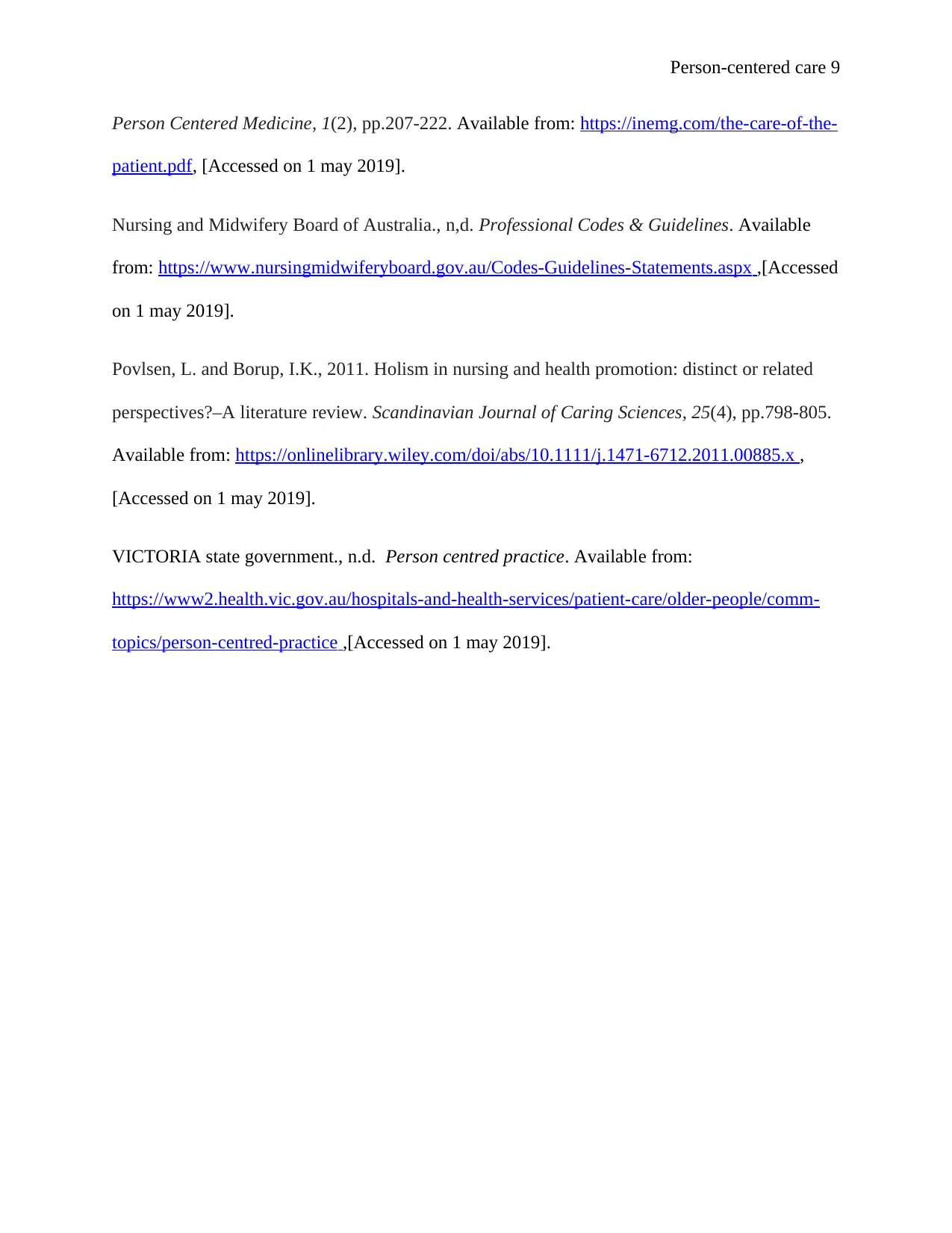
Person-centered care 9
Person Centered Medicine, 1(2), pp.207-222. Available from: https://inemg.com/the-care-of-the-
patient.pdf, [Accessed on 1 may 2019].
Nursing and Midwifery Board of Australia., n,d. Professional Codes & Guidelines. Available
from: https://www.nursingmidwiferyboard.gov.au/Codes-Guidelines-Statements.aspx ,[Accessed
on 1 may 2019].
Povlsen, L. and Borup, I.K., 2011. Holism in nursing and health promotion: distinct or related
perspectives?–A literature review. Scandinavian Journal of Caring Sciences, 25(4), pp.798-805.
Available from: https://onlinelibrary.wiley.com/doi/abs/10.1111/j.1471-6712.2011.00885.x ,
[Accessed on 1 may 2019].
VICTORIA state government., n.d. Person centred practice. Available from:
https://www2.health.vic.gov.au/hospitals-and-health-services/patient-care/older-people/comm-
topics/person-centred-practice ,[Accessed on 1 may 2019].
Person Centered Medicine, 1(2), pp.207-222. Available from: https://inemg.com/the-care-of-the-
patient.pdf, [Accessed on 1 may 2019].
Nursing and Midwifery Board of Australia., n,d. Professional Codes & Guidelines. Available
from: https://www.nursingmidwiferyboard.gov.au/Codes-Guidelines-Statements.aspx ,[Accessed
on 1 may 2019].
Povlsen, L. and Borup, I.K., 2011. Holism in nursing and health promotion: distinct or related
perspectives?–A literature review. Scandinavian Journal of Caring Sciences, 25(4), pp.798-805.
Available from: https://onlinelibrary.wiley.com/doi/abs/10.1111/j.1471-6712.2011.00885.x ,
[Accessed on 1 may 2019].
VICTORIA state government., n.d. Person centred practice. Available from:
https://www2.health.vic.gov.au/hospitals-and-health-services/patient-care/older-people/comm-
topics/person-centred-practice ,[Accessed on 1 may 2019].
⊘ This is a preview!⊘
Do you want full access?
Subscribe today to unlock all pages.

Trusted by 1+ million students worldwide
1 out of 9
Related Documents
Your All-in-One AI-Powered Toolkit for Academic Success.
+13062052269
info@desklib.com
Available 24*7 on WhatsApp / Email
![[object Object]](/_next/static/media/star-bottom.7253800d.svg)
Unlock your academic potential
Copyright © 2020–2025 A2Z Services. All Rights Reserved. Developed and managed by ZUCOL.





